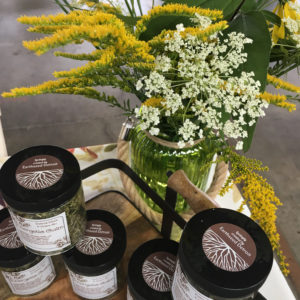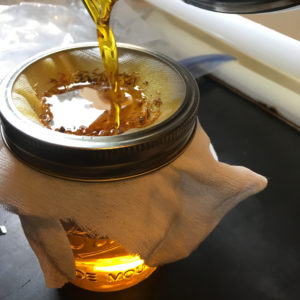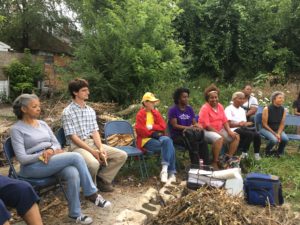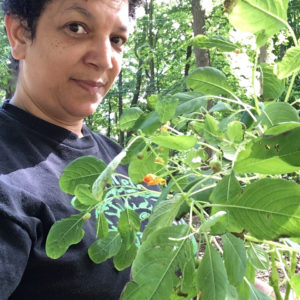Reconnecting to Nature and the Land Saved My Life
by Lottie Spady
In 2014 I started my formal herbal education and healing journey. In many ways I had lost my internal compass and was looking for yet another external solution to deal with the trauma and stresses of everyday life. I thought it would be interesting and something positive to occupy my time while I figured out a plan. What I got was so much more. Learning about herbal medicine re-introduced me to myself. I began to think about my health in a much more participatory manner. Instead of going to the doctor to see what they would say I needed, I began to ask myself what I could do for me. Not that there isn’t a place for allopathic medicine. I am thankful for life-saving drugs and procedures that are available to us. Yet, it is extremely encouraging to know that there is much we can do ourselves to promote overall health and well-being, treat common ailments, and help prevent chronic, long term debilitating illnesses.
I also believe the reconnection to nature and the land saved my life. Not through some miracle cure, potion or poultice—although there are some pretty wonderous potions and poultices to be had—but through the sense of empowerment and deep foundational healing that came about when I connected to something as ancient and ancestral as plant medicine. With this connection to the earth, I believe my body was able to reach back in time and rekindle the connection between my DNA and the constituents of species on earth thousands and thousands of years before my existence. These are our plant allies, which happen to be uniquely suited to human body system regulation, support, and healing. Archaeological evidence indicates that humans were using medicinal plants during the Paleolithic age, approximately 60,000 years ago. Five thousand years ago in Mesopotamia, the Sumerians studied clay tablets with hundreds of medicinal herbs such as myrrh and opium. Ancient texts such as the Egyptian Ebers Papyrus (c.1550 BCE) contained information on over 850 plant medicines, including garlic, juniper, cannabis, castor bean, and aloe.1,2

On any given day in Detroit, in the middle of a vacant lot, in your backyard, at a park or a community garden, you may be surrounded by dozens of humble power houses. There are medicinal and edible wild things growing in the crevices and cracks of broken sidewalks. They are independent, lush and abundant in forgotten spaces. These are species that stubbornly resist pesticides, plucking and torching. Despite our often negative feelings toward them, they come back every year as if to say, “You can count on me! I’m here for you!”
What if these weeds indicate our needs? What if this is Gaia, Mother Nature, once again calling out for us to listen and learn. What if we are being invited to a beautifully choreographed dance ideally suited to our health and well being?
You are likely to find some of the following remarkable healing plants in your backyard right now:
Plantain: Great externally for stings, bug bites, and rashes. Crush or chew up the leaves and rub on the affected area. Internally, as a tea, plantain is a tissue healer for everything from cold sores to hemorrhoids.
Burdock: This edible root is full of vitamins and minerals. It is also known to be a blood cleanser, helps with arthritis and other joint issues, aids in digestion and is a great source of protein.
Catnip: In the mint family. It drives cats crazy, but has the opposite effect on humans. Calming and soothing, it is a gentle sedative for the nerves. It is especially helpful with stomach distress, acid reflux, menstrual cramps, and gas.
Motherwort: A very bitter herb! Sweeten with honey for a tea that is good for heart health, soothes the nervous system, and can be helpful during menopause as well.
Dandelion: The entire plant is edible. The flowers can be simmered with organic sugar and water for a light golden syrup. The edible leaves are a digestive bitter and can be added to salads, cooked greens, soups or stews. The root is a liver detoxifier and can be roasted for a coffee-like beverage.
Red Clover: The edible flowers are great in salads. As a tea, red clover is good for respiratory health. It also supports women’s reproductive health.
Yellow Dock: May be used as a laxative. Also good for removing toxins in the body and reducing inflammation in the lymph system.
Goldenrod: As a tea, goldenrod is excellent for sinus and respiratory conditions. It may also be infused in oil for a very effective muscle and pain salve.

Maybe you’re not ready to go outside and forage for medicinals in your backyard. That’s OK. There are many ways to enhance your health with kitchen remedies from your local grocery store. Here are a few ideas:
Alternating between warm salt water and diluted apple cider vinegar gargles checked many a sore throat for my children.
When everyone in the house has caught The Bug, a pot simmering on the stove with sage, rosemary, thyme and basil will relieve the stuffy noses and chest congestion.
A syrup of raw honey infused with garlic, onion, and lemon will allow someone to have a good night sleep and not be kept awake by a troublesome cough.
Homemade herb-infused apple cider vinegar can be made into salad dressings, marinades, and added to greens, soups or stews to boost nutritional content.
Holding a bud of whole clove between your teeth will ease the pain of toothaches or sprouting wisdom teeth.
Chewing fennel seeds can help with indigestion.
Activated charcoal capsules are a must-have for food-related tummy troubles, food poisoning, the “stomach flu,” and when traveling.
Burning whole bay leaves as incense can clear the mind and help with focus and concentration and really shift the energy in the room in a positive way.
After a long, hard day or a work out, a hot bath in epsom salt can soothe the stress and strains.
RECIPE:
Slice a medium onion, smash a few cloves of garlic, and slice one small lemon. Put in a pot and cover with raw honey. Let simmer on very low heat for about 30 minutes.
Pour syrup into a mason jar and store in the refrigerator for several weeks. Take a spoonful to help boost your immune health, take as needed for a cold and cough and sinus conditions. For adults, children and babies one year and older. (No need to strain it. Eat the garlic and the onions or use them in cooking recipes, sauces, soup or stews.)
I have been teaching plant identification and herbalism classes in Detroit for the past four years. As a relatively new herbalist, I am thankful that my Detroit community allows me the opportunity to share as I learn. I see this work as directly connected and a natural extension of my decades-long history in environmental justice, food justice and media activism work. I call this program and process “do it yourself community health.”
Do-it-yourself community health is empowerment at the grassroots level, literally. The ability to make use of what one finds in their immediate vicinity is a true blessing and a gift from the Earth. It is exciting to be able to make healthy remedies and body products that do not have a lot of additives, chemicals, pesticides and herbicides for my own health and for my family and friends. Making these remedies is a lot of fun, relatively easy and inexpensive.

Do-it-yourself community health sounds like stories. One of the most enjoyable aspects of teaching community-based herbalism classes is hearing the stories and contributions of the participants. I love when someone shares a story about what their grandmother used to do or how they used to make medicine from a plant they found in their backyard. These are valuable exchanges that hold our history.
Do-it-yourself community health smells like spices and herbs that are simmering slowly on the stove. Being reduced into a concentrated syrup that can then support respiratory health in a city plagued by environmental injustices—such as what we just recently witnessed when the local Marathon plant was spewing foul-smelling emissions into the air.
Do-it-yourself community health feels fuzzy and soft like a wondrous mullein leaf. It feels comforting to a mom who knows that she can massage the soles of her agitated baby’s feet with lavender-infused oil so that he can get a good night’s sleep. It feels like power coursing through your veins, in your heart, and down into your fingertips when you can pull some leaves from the ground and create healing for your family, for your household, for your neighbor.
Do-it-yourself community health tastes refreshing and thirst-quenching, like a huge pitcher of freshly picked mint, steeped into a cool glass of iced tea. It tastes like a snappy salad dressing that was made from scratch with dandelion and burdock root. It tastes delicious, like dandelion leaf pesto! Yes, try it!
Do-it-yourself community health looks like children. It looks like children learning to make fire cider at the Detroit Independent Freedom School at the Charles H. Wright Museum. It looks like children learning plant identification at D-Town Farm on Children’s Day. It looks like a generation of children that grow up with a very different concept about self-care, medicine and taking care of themselves and community.
NOTE: Never eat or drink anything that you have not positively identified because it could make you sick or worse. Also, never forage or pick plants from polluted roadways or contaminated soil. Linking up with a community garden or farm is a good place to start exploring the rich wonder of weeds as medicine and food.
SOURCES:
1Urban Moonshine Blog by Guido Mase`, Clinical Herbalist
https://www.urbanmoonshine.com/blogs/blog/science-update-paleolithic-herbalism
2The Herbal Academy website, Herbal History page

Lottie V. Spady is a practicing herbalist, wild-crafter and community educator working at the intersection of media justice, food justice, environmental justice, community health, and civic engagement. She has been a Detroit activist for the past fifteen years developing programs, teaching workshops, and working specifically with children, teens and adults to promote, educate, and empower communities. She blogs about it at Earthseed Detroit.


